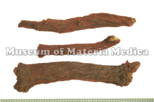Salvia Miltiorrhiza Root

|
Market name:丹参 Photo location:MMM, Inst. of Nat. Med. TMPW No.:4303 |
| Synonym | |
| Latin name | Salviae Miltiorrhizae Radix |
| Botanical source: Family name | Labiatae |
| Botanical source: Plant name | Salvia miltiorrhiza Bunge (IPNI:456707-1) |
| Part used | Root |
| Empirical criteria for quality selection | Good one is thick. The internal is purple black with white spots shaped like chrysanthemum. (NI) |
| Constituents | Diterpenoids: S. miltiorhiza: Tanshinone I, Tanshinone IIA, Tanshinone IIB, Cryptotanshinone, Tanshinol I, Tanshinol II; S. miltiorhiza: Danshenol A, Danshenol B, Dihydrotanshinone I, Cryptotanshinone, Tanshinone IIA, Danshexinkun A, Sugiol; S. deserta: 6,7-Dehydroroyleanone, Royleanone, 7-O-Methylhorminone, Taxodione, 7-O-Acetylhorminone, Horminone Phenylpropanoids: S. deserta: Salvianolic acid K, Salviaflaside, Rosmarinic acid, Lithospermic acid B; S. miltiorhiza: Lithospermic acid B (Lithospermate B) |
| Pharmacological effects | Improvement of spatial cognitive impairment, dilatation of coronary artery, protection of liver (lithospermic acid B), inhibition of aldose reductase, antifungal, endothelium dependent relaxation of the blood vessels (lithospermic acid B); improvement of kidney function (lithospermic acid B); and elimination of free-radical. |
| Indications | To promote blood circulation, stimulate menstrual discharge, relieve swelling and as a painkiller, it is used for paramenia, stomachache, menopause, hyperemesis and stomachache of after childbirth, rheumatism. |
| Diseases | Irregular menstruation, Menorrhalgia, Amenorrhea, Hyperemesis after childbirth, Anginal pain, Pain of lateral sides of trunk, Pyogenic dermatosis, Insomnia, Swelling and pain of joint |
| Formulas | Rarely used in formula. |
| Meridian tropism | Heart, Pericardium, Liver |
| Property | Slightly cold |
| Flavor | Bitter |
| Classification in "Shen-non Ben-cao Jing" | Superior |
| TCM: Classification | Drugs for invigorating blood circulation |
| TCM: Medicinal effects | To remove blood stasis and relieve pain, to promote the flow of blood and stimulate menstrual discharge, and to ease the mind. For menstrual disorders, amenorrhea, dysmenorrhea, mass formation in the abdomen, pain in acute arthritis and subcutaneous infections, fidgets and insomnia, hepatosplenomegaly, angina pectoris. |
| Remarks | Listed in the Japanese Pharmacopoeia 18th ed. |
| References | NI: N. Isshiki, Methods of Quality Evaluation and Preparation of Wakan-yaku, Tohodo Shoten, Tokyo, 1987. |
